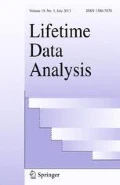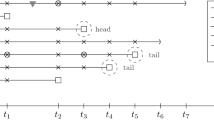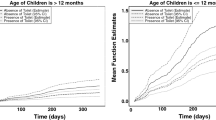Abstract
The case-cohort sampling, first proposed in Prentice (Biometrika 73:1–11, 1986), is one of the most effective cohort designs for analysis of event occurrence, with the regression model being the typical Cox proportional hazards model. This paper extends to consider the case-cohort design for recurrent events with certain specific clustering feature, which is captured by a properly modified Cox-type self-exciting intensity model. We discuss the advantage of using this model and validate the pseudo-likelihood method. Simulation studies are presented in support of the theory. Application is illustrated with analysis of a bladder cancer data.


Similar content being viewed by others
References
Akaike H (1974) A new look at the statistical model identification. IEEE Trans Autom Control 19(6):716–723. doi:10.1109/TAC.1974.1100705
Barlow WE (1994) Robust variance estimation for the case-cohort design. Biometrics 50(4):1064–1072
Barlow WE, Ichikawa L, Rosner D, Izumi S (1999) Analysis of case-cohort designs. J Clin Epidemiol 52(12):1165–1172
Borgan O, Langholz B, Samuelsen SO, Goldstein L, Pogoda J (2000) Exposure stratified case-cohort designs. Lifetime Data Anal 6(1):39–58
Breslow N (1972) Discussion of paper by D. R. Cox. J R Stat Soc Ser B (Methodol) 34:216–217
Byar D (1980) The veterans administration study of chemoprophylaxis for recurrent stage I baldder tumors: comparisons of placebo, pyridoxine, and topical thiotepa. In: Pavone-Macaluso M, Smith PH, Edsmyr F (eds) Bladder tumors and other topics in urological oncology. Plenum Press, New York, pp 363–370
Cai J, Prentice RL (1995) Estimating equations for hazard ratio parameters based on correlated failure time data. Biometrika 82(1):151–164. doi:10.1093/biomet/82.1.151. http://biomet.oxfordjournals.org/content/82/1/151.abstract, http://biomet.oxfordjournals.org/content/82/1/151.full.pdf+html
Cai J, Prentice RL (1997) Regression estimation using multivariate failure time data and a common baseline hazard function model. Lifetime Data Anal 3(3):197–213
Chornoboy E, Schramm L, Karr A (1988) Maximum likelihood identification of neural point process systems. Biol Cybern 59(4):265–275. doi:10.1007/BF00332915
Crane R, Sornette D (2008) Robust dynamic classes revealed by measuring the response function of a social system. Proc Natl Acad Sci 105:15649–15653
Engle RF, Russell JR (1998) Autoregressive conditional duration: a new model for irregularly spaced transaction data. Econometrica 66:1127–1162. http://www.jstor.org/stable/2999632
Errais E, Giesecke K, Goldberg LR (2010) Affine point processes and portfolio credit risk. SIAM J Financ Math 1:642–665
Felini M, Johnson E, Preacely N, Sarda V, Ndetan H, Bangara S (2011) A pilot case-cohort study of liver and pancreatic cancers in poultry workers. Annals of Epidemiology 21(10):755–766. doi:10.1016/j.annepidem.2011.07.001. http://www.sciencedirect.com/science/article/pii/S1047279711002079
Hawkes AG (1971) Spectra of some self-exciting and mutually exciting point processes. Biometrika 58(1):83–90
Koopman SJ, Lucas A, Monteiro A (2008) The multi-state latent factor intensity model for credit. J Econom 142:399–424
Kopperschmidt K, Stute W (2009) Purchase timing models in marketing: a review. AStA Adv Stat Anal 93:123–149. doi:10.1007/s10182-008-0096-8
Lu SE, Shih JH (2006) Case-cohort designs and analysis for clustered failure time data. Biometrics 62(4):1138–1148. doi:10.1111/j.1541-0420.2006.00584.x
Lu W, Tsiatis AA (2006) Semiparametric transformation models for the case-cohort study. Biometrika 93(1):207–214. doi:10.1093/biomet/93.1.207. http://biomet.oxfordjournals.org/content/93/1/207.abstract, http://biomet.oxfordjournals.org/content/93/1/207.full.pdf+html
Nan B (2004) Efficient estimation for case-cohort studies. Can J Stat 32(4):403–419. http://www.jstor.org/stable/3316024
Ogata Y (1988) Statistical models for earthquake occurrences and residual analysis for point processes. J Am Stat Assoc 83(401):9–27. http://www.jstor.org/stable/2288914
Prentice RL (1986) A case-cohort design for epidemiologic cohort studies and disease prevention trials. Biometrika 73:1–11
Self SG, Prentice RL (1988) Asymptotic distribution theory and efficiency results for case-cohort studies. Ann Stat 16(1):64–81
Teich MC, Saleh BEA (2000) Branching processes in quantum electronics. IEEE J Sel Top Quantum Electron 6(6):1450–1457
Therneau T (2012) A package for survival analysis in S. R package version 2.37-2. http://CRAN.R-project.org/package/survial
Therneau TM, Hamilton SA (1997) rhDNase as an example of recurrent event analysis. Stat Med 16:2029–2047. doi:10.1002/(SICI)1097-0258(19970930)16:18<2029::AID-SIM637>3.0.CO;2-H
Therneau TM, Li H (1999) Computing the Cox model for case cohort designs. Lifetime Data Anal 5(2):99–112
Vere-Jones D (1995) Forecasting earthquakes and earthquake risk. Int J Forecast 11(4):503–538. doi:10.1016/0169-2070(95)00621-4. http://www.sciencedirect.com/science/article/B6V92-3XWRN36-2/2/fe30ea6bc743e2109d4968681d73d61d
Wei LJ, Lin DY, Weissfeld L (1989) Regression analysis of multivariate incomplete failure time data by modeling marginal distributions. J Am Stat Assoc 84(408):1065–1073. http://www.jstor.org/stable/2290084
Zeng D, Lin DY, Avery CL, North KE, Bray MS (2006) Efficient semiparametric estimation of haplotype-disease associations in case-cohort and nested case-control studies. Biostatistics 7(3):486–502. doi:10.1093/biostatistics/kxj021. http://biostatistics.oxfordjournals.org/content/7/3/486.abstract, http://biostatistics.oxfordjournals.org/content/7/3/486.full.pdf+html
Zhang H, Schaubel DE, Kalbfleisch JD (2011) Proportional hazards regression for the analysis of clustered survival data from case-cohort studies. Biometrics 67(1):18–28
Zhuang J, Ogata Y, Vere-Jones D (2002) Stochastic declustering of space-time earthquake occurrences. J Am Stat Assoc 97(458):369–380. doi:10.1198/016214502760046925
Acknowledgments
We would like to thank the Associate Editor and two anonymous referees for their valuable comments, which have led to improved presentation. F.C. was supported by a University of New South Wales (UNSW) Early Career Researcher grant and a UNSW Faculty Research Grant. K.C. was supported by Hong Kong Research Grants Council Grants (601011 and 601612).
Author information
Authors and Affiliations
Corresponding author
Appendix
Appendix
1.1 Sketch proof of Proposition 1
Although due to the presence of the self-exciting component, our model is not a special case of the model considered by Self and Prentice (1988), the asymptotic properties of the pseudo likelihood based estimator can be proved along the same lines of Self and Prentice (1988) for the Cox proportional intensity model. Here we present a sketch of the technical arguments using the empirical approximation method. The conditions C3–C5 ensure that \(\varPsi (t, \theta )Y( t) \) is \(P\)-Glivenko–Cantelli over \([0, t_0] \times \varTheta \) for any fixed \(t_0>0\). As a result,
uniformly over \([0, \tau ] \times \varTheta \) with probability one. It follows that, uniformly over \(\varTheta \),
where
Observe that, for any positive random variable \(\zeta \) and nonnegative \(\eta \) with positive mean, Jensen’s inequality implies \( \mathrm{E }[\eta \log \zeta ]/\mathrm{E }[\eta ] \le \log \mathrm{E }[\zeta \eta ] - \log \mathrm{E }[\eta ].\) Set \(\zeta = \exp \{\varPsi (t, \theta ) - \varPsi (t, \theta _0)\}\) and \(\eta = \exp \{\varPsi (t, \theta _0)\} Y(t) \mu (t)\). It is seen that the integrand in the second expression of \(l(\theta )\) achieves a unique maximum when \(\theta =\theta _0\). By C4, \(l(\theta )\) achieves maximum only at \(\theta _0\). The uniform convergence over \(\varTheta \) implies that \( \hat{\theta }\) is strongly consistent.
The asymptotic normality is proved by the Taylor expansion in a small neighborhood of \(\theta _0\). Similar to the definition of \(r^{(k)}\) and \(\tilde{R}^{(k)}\), let
The principal derivation is
Observe that \(\epsilon _j\) are membership indicators for simple random sampling without replacement and the asymptotic normality of \(\hat{\theta }\) follows.
Rights and permissions
About this article
Cite this article
Chen, F., Chen, K. Case-cohort analysis of clusters of recurrent events. Lifetime Data Anal 20, 1–15 (2014). https://doi.org/10.1007/s10985-013-9275-3
Received:
Accepted:
Published:
Issue Date:
DOI: https://doi.org/10.1007/s10985-013-9275-3




